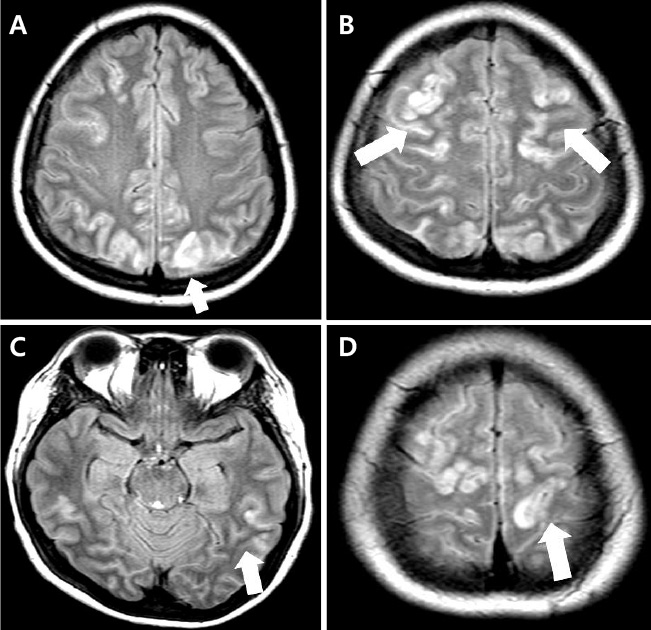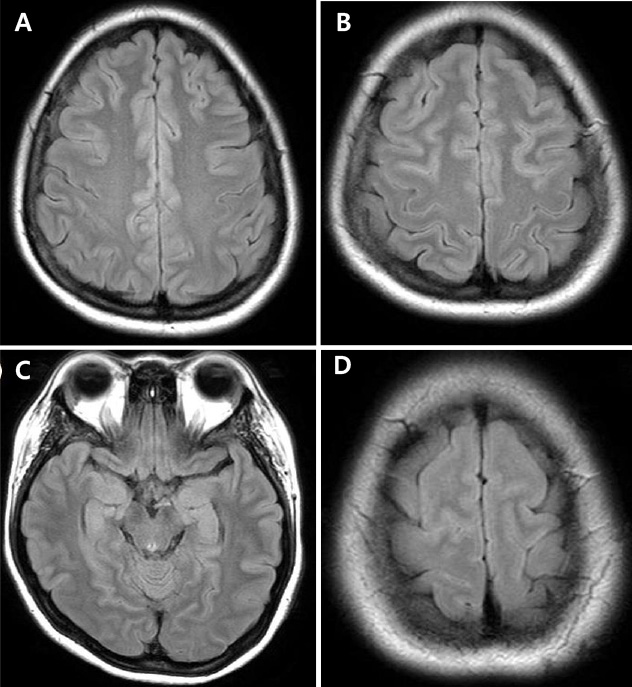Perinatology.
2019 Sep;30(3):179-182. 10.14734/PN.2019.30.3.179.
Posterior Reversible Encephalopathy Syndrome in Late Postpartum Eclampsia: A Case Report
- Affiliations
-
- 1Department of Obstetrics and Gynecology, Inje University Busan Paik Hospital, Busan, Korea. obgyjeong@hanmail.net
- 2Paik Institute for Clinical Research, Inje University Busan Paik Hospital, Busan, Korea.
- KMID: 2460033
- DOI: http://doi.org/10.14734/PN.2019.30.3.179
Abstract
- Late postpartum eclampsia is defined as the onset of a seizure more than 48 hours after delivery. Posterior reversible encephalopathy syndrome (PRES) is a clinical-radiological entity characterized by clinical manifestations such as seizures, headaches, visual disturbances, altered mental status, and characteristic magnetic resonance imaging findings, including sub-cortical vasogenic edema at the bilateral parietal and occipital lobes. Late postpartum eclampsia concurrent with PRES is rare, and not always preceded by preeclampsia before delivery. We report the case of a 26-year-old woman who developed PRES with late postpartum eclampsia 5 days after cesarean delivery but did not have hypertensive disease during pregnancy.
MeSH Terms
Figure
Reference
-
1. Tranquilli AL, Dekker G, Magee L, Roberts J, Sibai BM, Steyn W, et al. The classification, diagnosis and management of the hypertensive disorders of pregnancy: a revised statement from the ISSHP. Pregnancy Hypertens. 2014; 4:97–104.
Article2. Lubarsky SL, Barton JR, Friedman SA, Nasreddine S, Ramadan MK, Sibai BM. Late postpartum eclampsia revisited. Obstet Gynecol. 1994; 83:502–505.
Article3. Hinchey J, Chaves C, Appignani B, Breen J, Pao L, Wang A, et al. A reversible posterior leukoencephalopathy syndrome. N Engl J Med. 1996; 334:494–500.
Article4. Fugate JE, Rabinstein AA. Posterior reversible encephalopathy syndrome: clinical and radiological manifestations, pathophysiology, and outstanding questions. Lancet Neurol. 2015; 14:914–925.
Article5. Karampekios SK, Contopoulou E, Basta M, Tzagournissakis M, Gourtsoyiannis N. Hypertensive encephalopathy with predominant brain stem involvement: MRI findings. J Hum Hypertens. 2004; 18:133–134.
Article6. Choh NA, Jehangir M, Rasheed M, Mira T, Ahmad I, Choh S. Involvement of the cervical cord and medulla in posterior reversible encephalopathy syndrome. Ann Saudi Med. 2011; 31:90–92.
Article7. Chen TY, Lee HJ, Wu TC, Tsui YK. MR imaging findings of medulla oblongata involvement in posterior reversible encephalopathy syndrome secondary to hypertension. AJNR Am J Neuroradiol. 2009; 30:755–757.
Article8. Ono Y, Manabe Y, Hamakawa Y, Murakami T, Omori N, Hayashi Y, et al. Localized lesions on MRI in a case of hypertensive brainstem encephalopathy. Intern Med. 2005; 44:1002–1005.
Article9. Ekawa Y, Shiota M, Tobiume T, Shimaoka M, Tsuritani M, Kotani Y, et al. Reversible posterior leukoencephalopathy syndrome accompanying eclampsia: correct diagnosis using preoperative MRI. Tohoku J Exp Med. 2012; 226:55–58.
Article10. Servillo G, Bifulco F, De Robertis E, Piazza O, Striano P, Tortora F, et al. Posterior reversible encephalopathy syndrome in intensive care medicine. Intensive Care Med. 2007; 33:230–236.
Article11. Brewer J, Owens MY, Wallace K, Reeves AA, Morris R, Khan M, et al. Posterior reversible encephalopathy syndrome in 46 of 47 patients with eclampsia. Am J Obstet Gynecol. 2013; 208:468.e1–468.e6.
Article12. Wagner SJ, Acquah LA, Lindell EP, Craici IM, Wingo MT, Rose CH, et al. Posterior reversible encephalopathy syndrome and eclampsia: pressing the case for more aggressive blood pressure control. Mayo Clin Proc. 2011; 86:851–856.
Article13. Sibai BM. Diagnosis, prevention, and management of eclampsia. Obstet Gynecol. 2005; 105:402–410.
Article14. Which anticonvulsant for women with eclampsia? Evidence from the collaborative eclampsia trial. Lancet. 1995; 345:1455–1463.15. Chames MC, Livingston JC, Ivester TS, Barton JR, Sibai BM. Late postpartum eclampsia: a preventable disease? Am J Obstet Gynecol. 2002; 186:1174–1177.
Article
- Full Text Links
- Actions
-
Cited
- CITED
-
- Close
- Share
- Similar articles
-
- Posterior reversible encephalopathy syndrome after normal vaginal delivery: A case report
- Reversible Cerebral Vasoconstriction Syndrome Combined with Posterior Encephalopathy Syndrome, and Transient Splenial Lesion after Delivery
- A Case of Posterior Reversible Encephalopathy Syndrome in a Patient having Continuous Ambulatory Peritoneal Dialysis
- Late Postpartum Eclampsia: A Case Report
- Interrelationship between Cerebral Vasospasm and Vasogenic Edema in Eclampsia Complicated by Posterior Reversible Encephalopathy Syndrome (PRES): a Case Report



